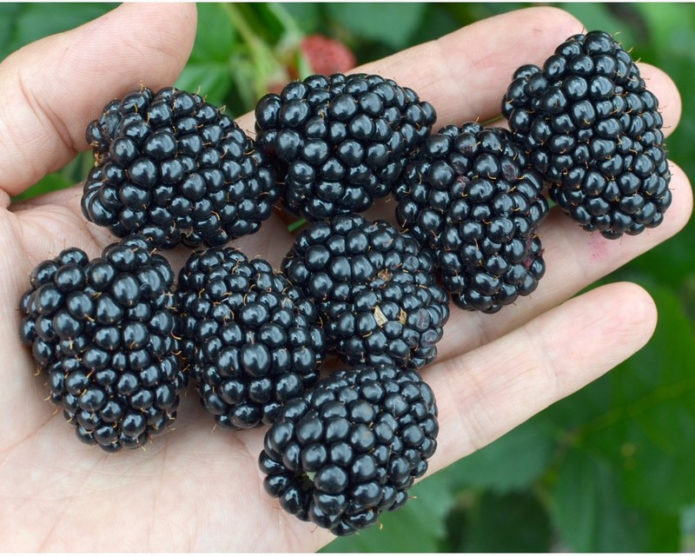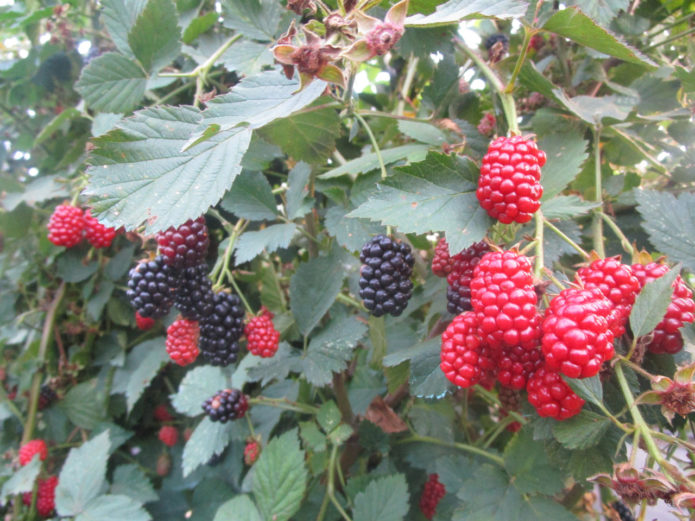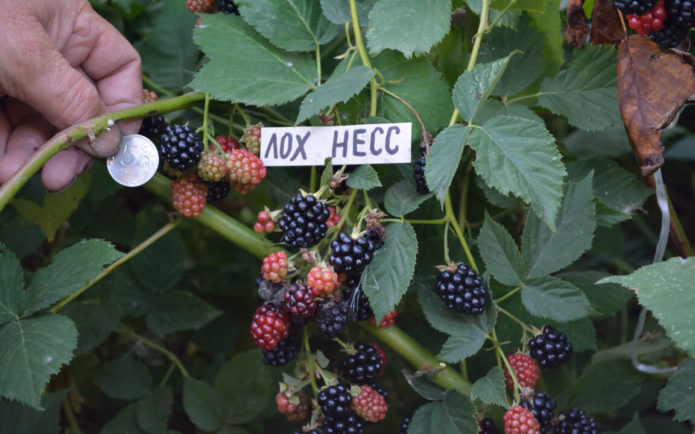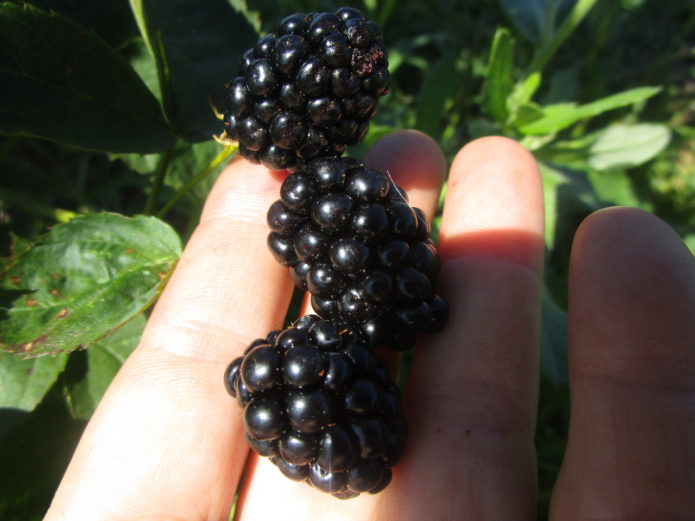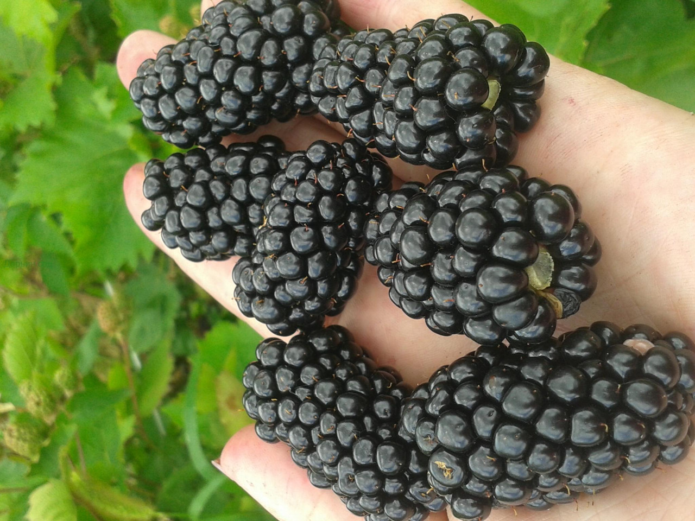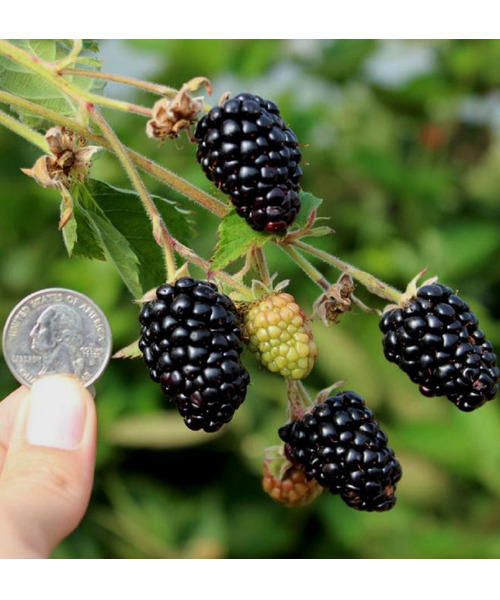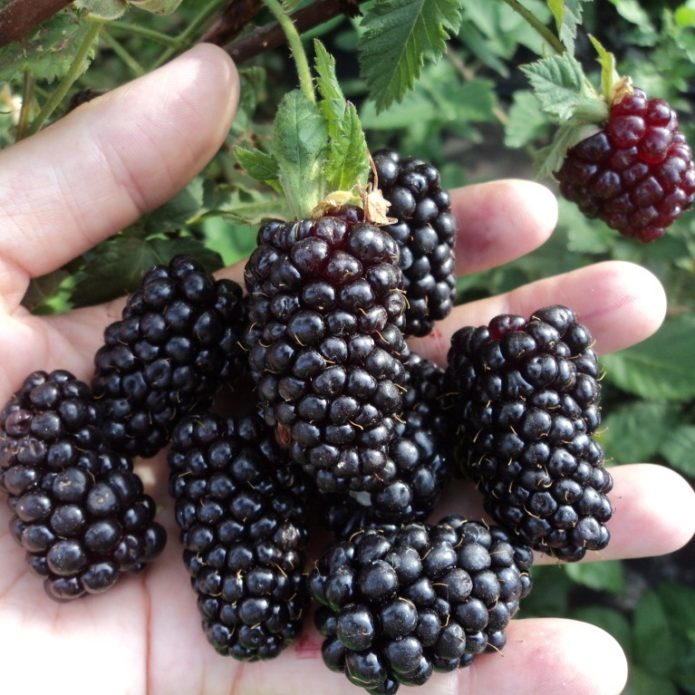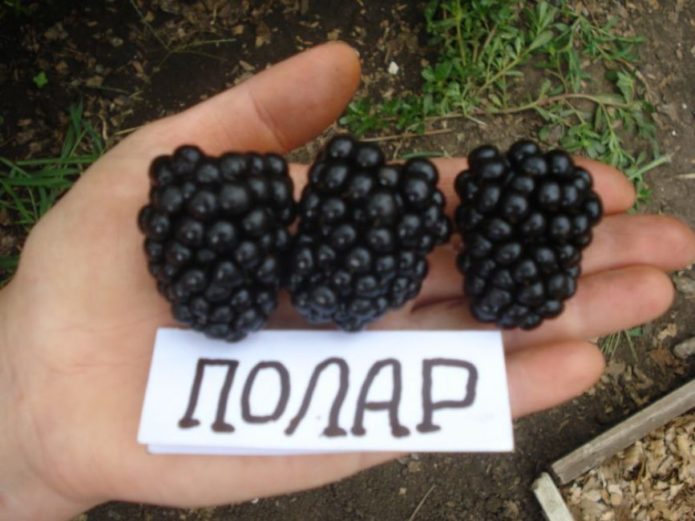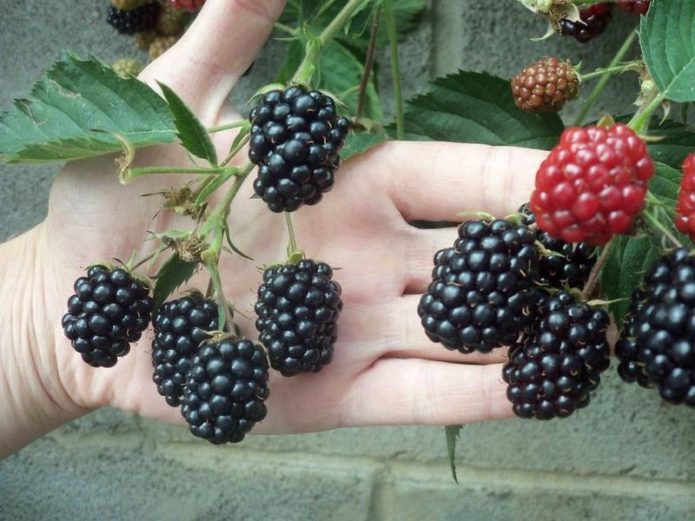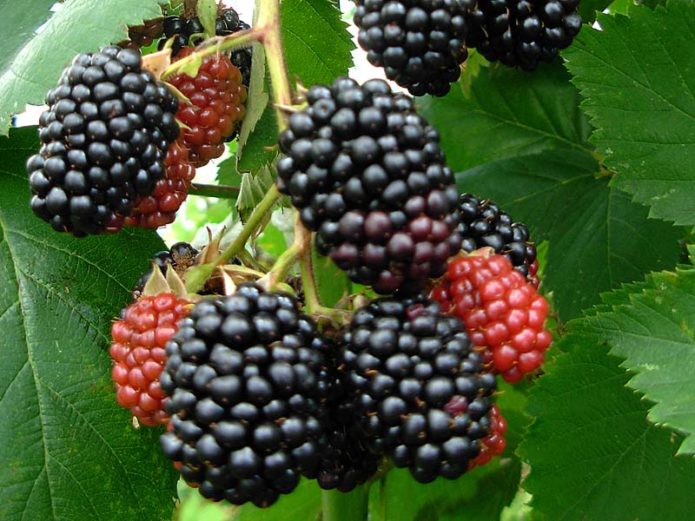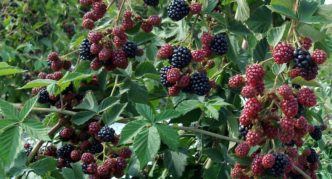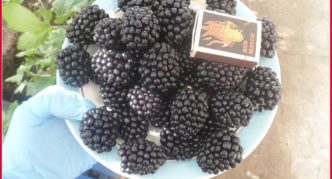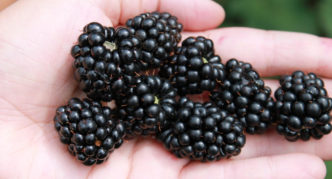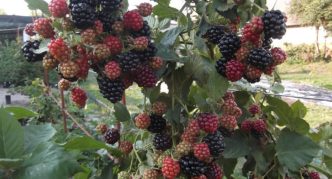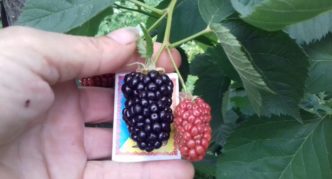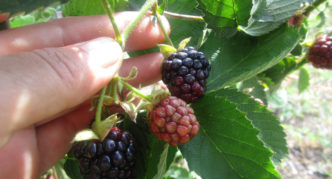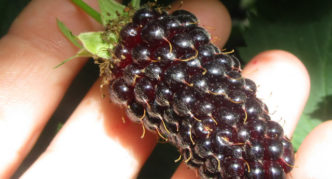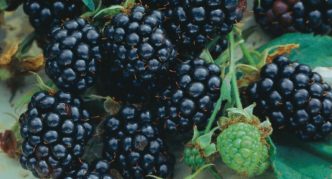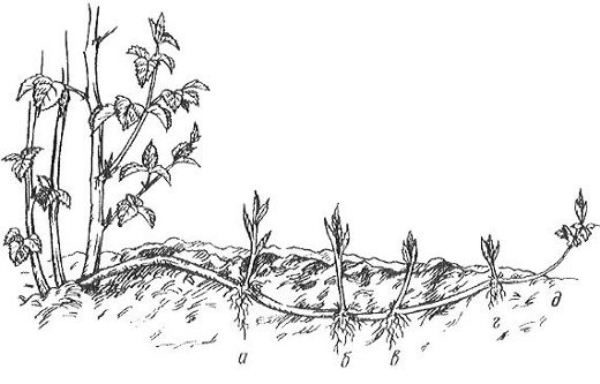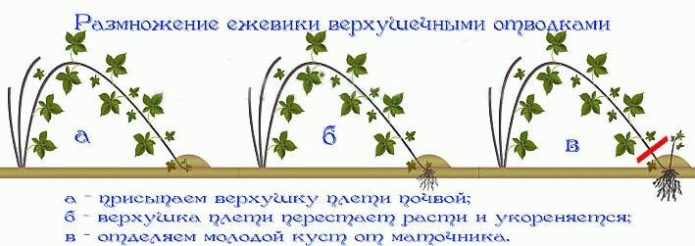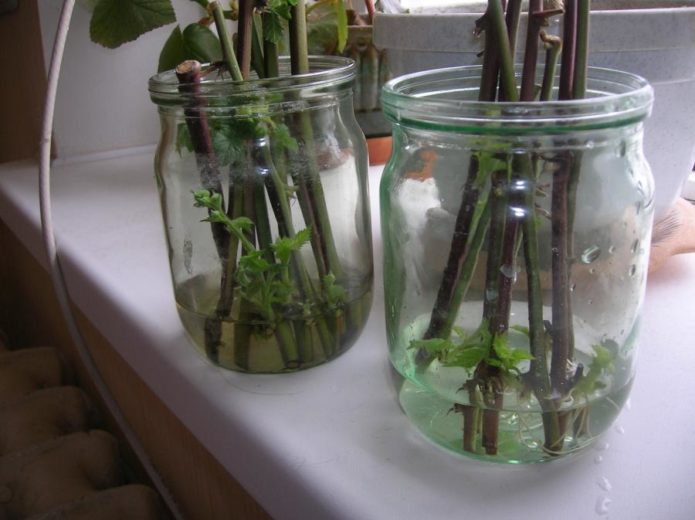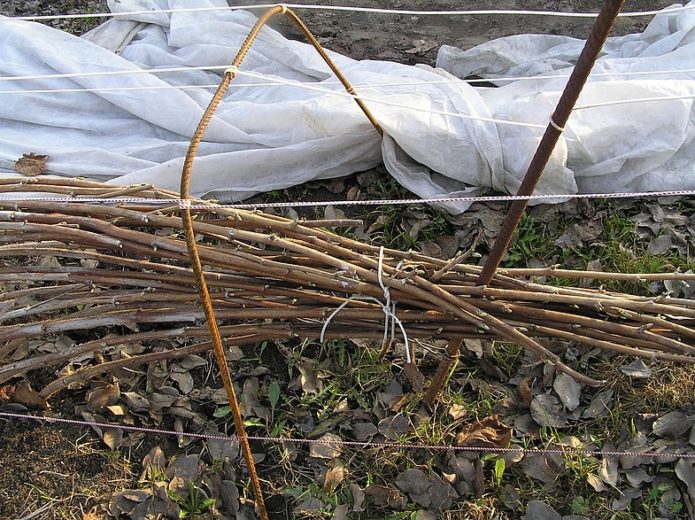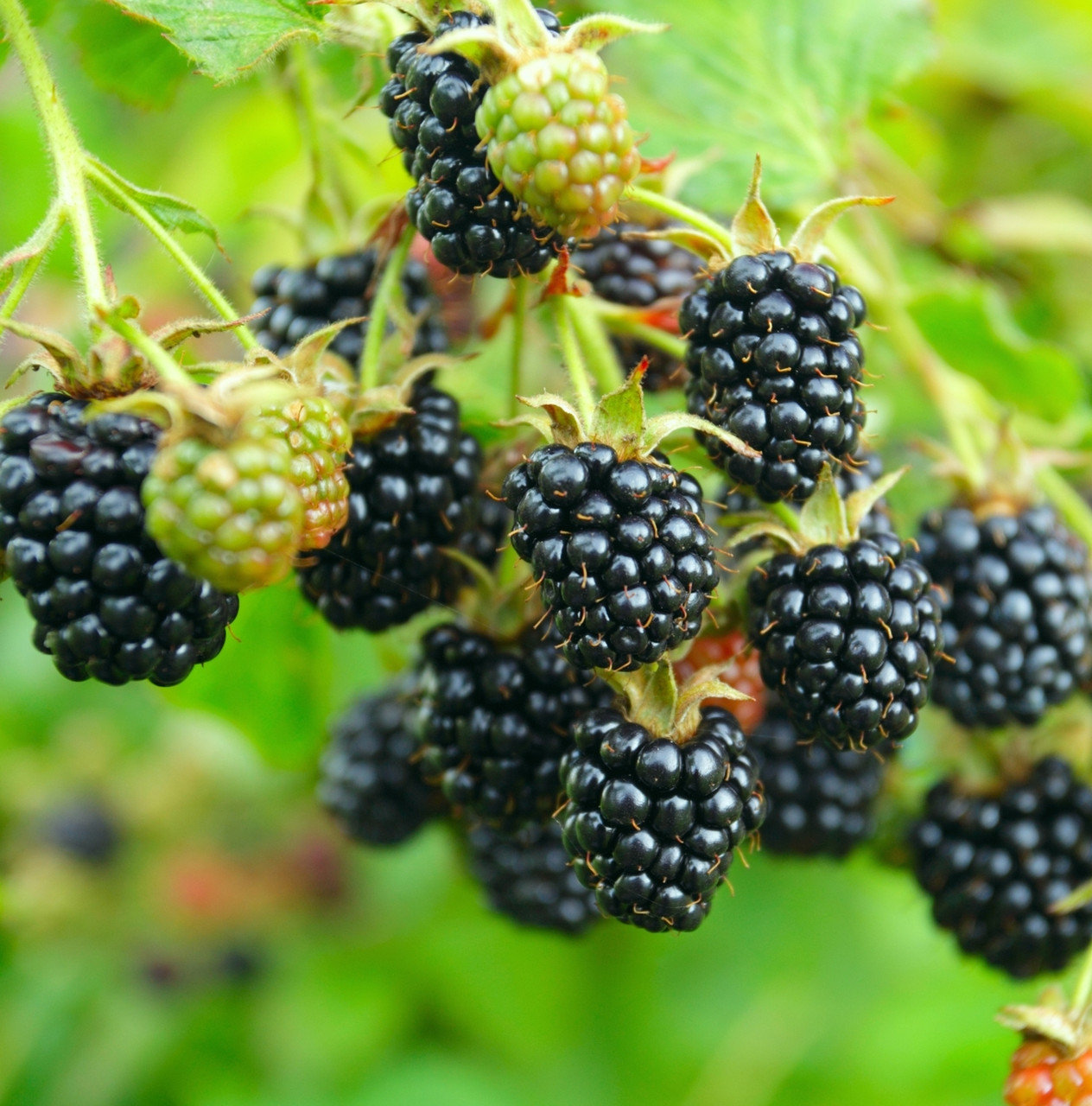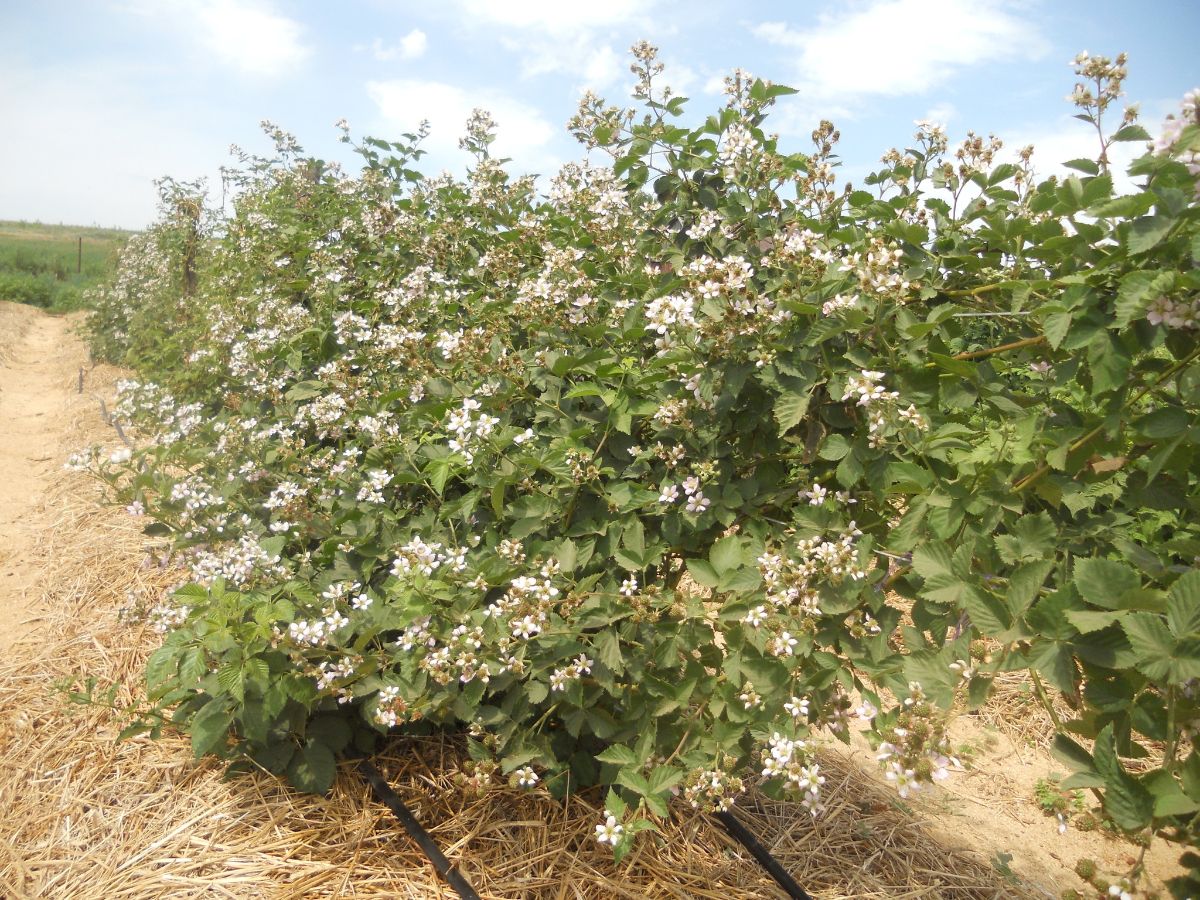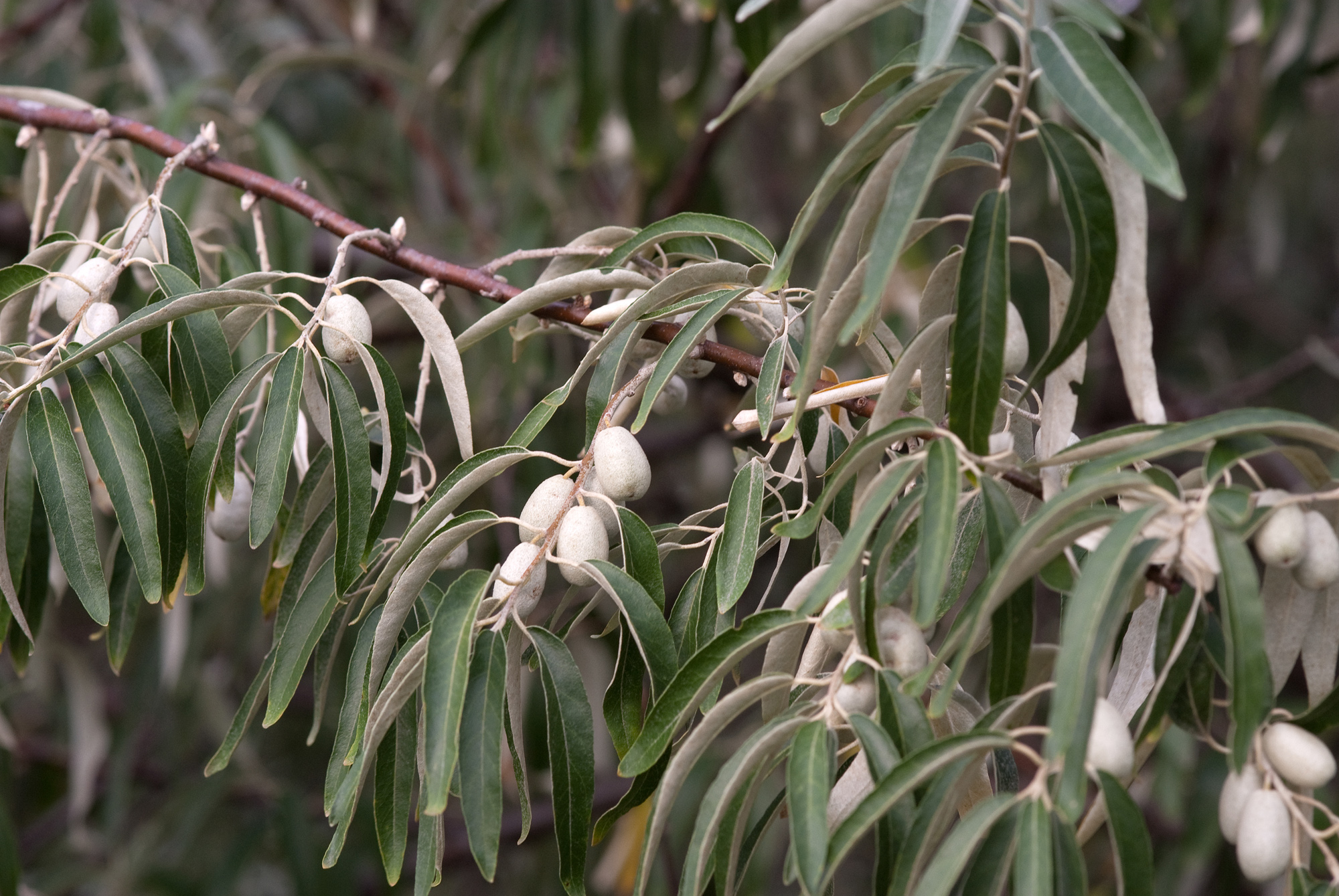Blackberries are quite rare in household plots. This is not surprising. Few gardeners decide to grow a shrub covered with sharp thorns and bearing small, sour berries, almost devoid of aroma. But thanks to the efforts of breeders in recent years, many modern varieties have appeared that change the idea of this culture. Their shoots are devoid of thorns, and the berries are impressive in size and have a rather sweet pleasant taste. In terms of yield, thornless varieties are also often superior to their thorny counterparts.
Content
Popular thornless blackberry varieties
The thornless blackberry is a man-made culture that does not occur in nature. Nowadays, there are many varieties of it, differing from each other in terms of ripening, the presence or absence of signs of remontability, yield and, of course, the taste of the fruit.
Early
Early thornless blackberry varieties reach harvest maturity in the first half of summer. In the southern regions, this period usually falls in mid or late June, and in the northern regions, in July. Their main advantage lies in the fact that they manage to fully bear fruit even in a short summer.
Loch Tay
Ultra early thornless variety, bred in Scotland. In most of the territory of our country, its berries ripen in the first half of July, but in the southernmost regions they begin to harvest at the end of June. Duration of fruiting is 3-4 weeks.
Loch Tei is characterized by semi-spreading shoots up to 5 m long. It forms root shoots only in exceptional cases, for example, when the root system is damaged during digging. Loch Teya berries are large, elongated, when ripe they acquire a black, shiny color. The taste is sweet, with a refreshing sourness. The productivity of the variety is high. Each plant over 3–4 years old, under favorable conditions, yields up to 20 kg of berries that are well tolerated in storage and transportation. You can collect them both manually and using combines.
List of successful varieties and hybrids of blackberries, care and cultivation features:https://flowers.bigbadmole.com/en/yagody/ezhevika-sorta-opisanie-foto.html
Loch Tei is excellent in hot and dry weather. It is also immune to most viral and fungal diseases, including root anthracnose.Among the shortcomings of the variety, gardeners note only insufficient winter hardiness for most regions of Russia and medium resistance to rust.
Video: fruiting bushes Loch Tey
Loch Maree
Another early variety, born thanks to Scottish breeders. It begins to ripen about a week later than Loch Teya and differs from other varieties in its very decorative flowers, unusual for blackberries in pink color.
Loch Mary bushes semi-erect, with long shoots. The berries are round, black, glossy, with small seeds, almost invisible when eaten. Their average weight ranges from 5 to 8 g, and the maximum is 10 g. The pulp is sweet, with a slight sourness in taste and berry aroma.
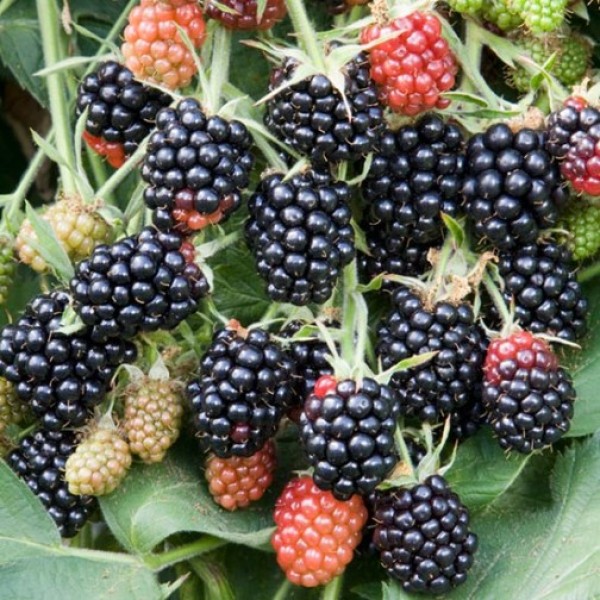
Loch Mary cannot boast of outstanding size of berries, but this shortcoming is more than compensated for by the excellent taste.
Loch Mary does not tolerate low temperatures, and high humidity often leads to infection of berries with gray rot. The variety suffers very rarely from other diseases. It is also resistant to pests.
Orkan
The time-tested, studless variety of Polish selection with an early ripening period. It practically does not give root suckers, but it reproduces well by rooting the tops.
Orcan forms upright bushes no more than 3 m in height. Berries are elliptical, black, weighing 4–8 g. The flesh is sweet and sour, with a blackberry aroma. Ripe Orkan fruits quickly deteriorate, so they are removed slightly unripe for storage and transportation.
The variety rarely suffers from infections and pests. In the conditions of Poland, it easily tolerates wintering, but in Russia and Ukraine it needs additional shelter. It also reacts badly to the lingering summer rains. With an excess of moisture, Orkan berries can lose sugar content and density, which significantly impairs their taste.
Unique large-fruited garden blackberry Karaka Black:https://flowers.bigbadmole.com/en/yagody/ezhevika-karaka-blek.html
Late
Late varieties of thornless blackberries ripen in late summer and early autumn. This allows you to get tasty and aromatic berries at a time when most crops are already dormant. But in regions with short summers, such varieties often cannot reveal their full potential, since they do not have time to give the harvest before the frost begins.
Loch Ness
Medium late variety of Scottish selection. In the south of the Russian Federation and in Ukraine, it reaches harvest maturity at the end of July, and in the middle lane - in the first half of August. The fruiting period of this variety usually does not exceed 4–6 weeks, which makes it possible to collect almost all the berries before sub-zero temperatures are established.
Loch Ness is a powerful semi-spreading type shrub up to 4 meters high, which forms a large number of root shoots. Berries are elliptical, black, large. At the first harvest, their average weight is 10 g, in subsequent ones - it decreases to 4–5 g. The pulp is juicy and firm. At the stage of technical ripeness, it is sourish, but after full ripening it acquires a sweet taste with a characteristic aroma.
Loch Ness has a pretty high yield. Each bush can bring 5–25, and with intensive farming and 30 kg of berries. Its advantages also include:
- good keeping quality of fruits;
- suitability for mechanized harvesting;
- resistance to diseases and pests;
- the ability to withstand temperatures as low as -17–20 ° C.
Ruczaj
Polish variety with medium late ripening. At home, his berries begin to be picked in the second decade of August, but in Russia and Ukraine they ripen a little later.
Rushai is a semi-sheathing shrub with numerous, highly branched shoots. The berries are elongated, slightly lumpy, purple-black. Their average weight varies from 3 to 5 g. The pulp is sweet, slightly sour and very aromatic. The yield is high.One bush can bring up to 20 kg of berries, which, due to their delicate consistency, do not tolerate storage and transportation.
Rushay is rarely affected by diseases and pests. Winter hardiness is very low. Already at air temperatures below -6 ° C, he needs additional shelter.
Repaired
Repaired varieties are capable of producing crops twice a season. At the beginning of summer, berries are formed on two-year-old, overwintered shoots, and at the end - on annuals. But planting remontant varieties in regions with short summers is very risky. Early flowering two-year-old shoots often suffer from recurrent frosts, and annuals may not have time to yield before snowfalls.
Most gardeners grow the thornless blackberry remontant in a one-year cycle, mowing the fruit-bearing shoots immediately after harvest. This allows you to get an earlier and plentiful harvest of berries on the stems of the first year of life. Leaving shoots for the second year is practiced only in the southernmost regions or in greenhouses.
The following spineless remontant varieties are presented on the Russian market:
- Prime-Ark Freedom. Its first fruiting occurs in early June, and the second - in mid or late August. The berries are large, weighing 9–10 g, in the second harvest - up to 16 g. They tolerate storage and transportation well. The pulp is juicy, sweet, with a pleasant sourness. The yield of the variety is up to 7 kg per plant. Blackberry bushes Prime-Arc Freedom erect. They form a sufficient number of root sprouts and reproduce well. Winter hardiness is very low. Shoots of Freedom's Prime Arc can die in temperatures below -14 ° C.
- Prime-Ark Traveler. The newest member of the Prime Ark family, patented in 2016. Brings transportable, sized, elongated berries with firm but juicy pulp. The taste is sweet, with a pronounced aroma. Resistant to most infections, including anthracnose and rust. High temperatures can cause significant damage to the harvest of Prime Arc Travel, which often leads to a decrease in flowering intensity and crushing of berries. He does not tolerate severe frosts. Productivity - 3-4 kg per bush.
- Amara (Amara). A repaired, thornless variety with dense berries weighing up to 15 g. The pulp is firm, sweet, without a bitter taste. It takes about 75 days from flowering to fruiting. Low winter hardiness.
Video: personal experience of growing blackberries by Prime-Arc Freedom
Winter hardy
Thornless blackberry is a thermophilic culture. Most of its varieties do not tolerate temperatures below -10-15 ° C. But some of them are able to withstand frosts of 20-30 ° C.
Polar
This is a Polish variety with erect shoots no more than 2.7 m high. It tolerates a drop in air temperature to -25-30 ° C, but wintering in extreme conditions often leads to a decrease in yields due to damage to flower buds.
Black shiny Polar berries are oval in shape and have a pleasant sweet and sour taste with a bright blackberry aroma. Their average weight is about 10–12 g. Keeping quality is good.
In the southern regions, the first Polar berries ripen at the beginning of July, in Central Russia, the fruiting dates are shifted one month ahead. The yield of the variety often exceeds 8 kg per plant.
Guy
Guy is a studless winter-hardy variety bred by the famous Polish breeder Jan Danek. Its erect shoots remain viable at air temperatures of -30 ° C, but flower buds are not so resistant, therefore, severe cold often causes a decrease in the number of fruits.
Guy's berries are black, round-elongated, with dense, but juicy pulp. The taste is sweet, with an unobtrusive sourness and a delicate silky aroma. The commercial qualities of the variety are very high. Its fruits tolerate transportation and storage well, and are also suitable for processing.
Guy is a mid-early variety. In the south, it ripens in early July, and in Central Russia 20–25 days later. Productivity - up to 15 kg per bush.
Video: fruiting varieties Guy
Cacanska Bestrna
A variety of Serbian selection, widespread in this country. The manufacturer recommends it both for growing in small gardens and for industrial cultivation.
Chachanska Bestrna forms semi-erect bushes with lashes up to 3.5 m long. The berries of this variety are black, oval-elongated, with a sweet and sour taste. Their average weight is 9.4 g, and the maximum weight can reach 14.5–15.5 g. The variety reaches ripening in late July and early August. Usually, an active yield of the crop lasts 4-5 weeks, until the first days of September.
Blackberries of this variety are capable of withstanding frosts down to -26 ° C. It is resistant to heat and drought and is also rarely attacked by diseases and pests.
One of the first cultivated blackberry varieties was Thornfrey, which quickly gained popularity due to its high yield, total absence of thorns and ease of maintenance:https://flowers.bigbadmole.com/en/yagody/ezhevika-tornfri-opisanie-sorta-foto-otzyivyi.html
American selection
Breeders in the United States of America began working on the development of thornless forms of blackberries in the middle of the last century. In 1966, they obtained the first variety with the required qualities. He received the name Thornfrey, which translated from English means free from thorns.
American breeders retain their leadership in this industry to this day. For more than 60 years of work, they have obtained many thornless varieties of blackberries, which are in high demand among gardeners in various countries, including Russia.
Table: popular thornless blackberry varieties from the USA
| Variety name | Ripening period | Resistance to difficult climatic conditions, diseases and pests | Productivity (kg per plant) | Bush characteristic | Features of fruits | |||
| Weight (g) | The form | Taste | Other features | |||||
| Thonfree | Late (August-September) | Easily tolerates high temperatures and drought, but can be affected by gray mold, weevil and mice. Winter hardiness - up to -18 ° C | 15–20 (from individual bushes to 30) | Stunted, with powerful, semi-spreading shoots | 4,5–5 | Oval | Sweet, with a faint, delicate aroma. Taste assessment by experts:
| Great for freezing. |
| Apaches (Apache) | Late | Sensitive to lack of moisture and temperatures above +40 ° C or below -20 ° C | Up to 5 | Erect, powerful, 2.5-3 m high | To 10 | Cone-shaped | Sour sweet | Retain their shape during transportation and storage |
| Black satin | Late (August-September) | Resistant to major infections, with the exception of gray mold, which often infects berries if picked irregularly | 5–8 (with intensive farming up to 25) | Powerful, with creeping shoots up to 7 meters long. | Up to 8 | Rounded | Sweet and sour, with a rich aroma | Removed fully ripe, quickly deteriorate and cannot tolerate transportation |
| Chester Thornless | Medium late (August-September) | Differs in high winter hardiness (up to -30 ° C) and the presence of immunity to major diseases, including gray rot | Up to 20 | Semi-spreading type with highly branching shoots up to 3 m long. | 5–7 | Rounded | Sweet, with a rich forest blackberry aroma | Thanks to the dense skin, they are well stored and transported, and also retain their shape when frozen |
| Natchez | Early | Resistant to diseases and pests, but reacts negatively to high temperatures, lack of moisture.Frosts below -14 ° C are also dangerous for him | 15–20 | Semi-upright, with shoots up to 7 m long | 7–9 | Cylinder | Sweet, with subtle sourness and rich blackberry aroma | Natchez berries are eaten fresh and used to make stewed fruit, jams and even wine. Good keeping quality |
| Osage | Mid-early | Resistant to heat and major infections. Winter hardiness - up to -13 ° C | 3 | Erect, with high vigor. Shoot length - 1.5-1.7 m | 5–7 | Rounded | Sweet, with a subtle fruity aroma | Due to its high density, it does not wrinkle during transportation and storage |
| Columbia Star | Mid-early (second half of June-early July) | Easily copes with lack of moisture, but can die at air temperatures below -14 ° C. Resistant to common infections and pests. | Up to 7.5 | Creeping, lash length up to 5 m | 7–8 | Cone-shaped | Sweet and sour, with cherry and raspberry notes in the aroma. | Columbia berries are eaten fresh and used to make stewed fruit, jams and other processed products. They remain marketable for a long time and tolerate transportation well. |
| Triple Crown | Medium late (end of July - second half of August) | Weak winter hardiness. At very high temperatures, it needs shading. Rarely affected by infections and insect pests | 13–15 | Semi-creeping or erect, with shoots about 3 m long | About 8 | Rounded or slightly elongated | Sweet, with a berry aftertaste and slight sourness | The pulp is juicy, but dense, so that the berries do not crumple during long-term transportation or storage |
Photo gallery: popular varieties of American selection
- In 2006, the Thornfrey variety was introduced to the Russian State Register as a crop. recommended for cultivation throughout the country
- Fruiting of the Apache variety lasts about 4-5 weeks
- In the middle lane and other regions with a temperate climate, Black Satin often does not have time to bear fruit until the first frost
- The main advantage of the Chester Thornless variety is the combination of high density of berries with good taste.
- Berries variety Natchez, even when overripe, do not lose density
- Osage is not very fruitful, but very tasty
- Columbia Star variety is suitable for mechanized harvesting
- Triple Crown has been cultivated in different countries for over 20 years.
Features of growing thornless blackberries
Agrotechnics of thornless blackberry varieties has its own subtleties. They are more demanding on heat than the thorny representatives of this culture, and need more nutrients and moisture.
Landing
The choice of where to grow the thornless blackberry depends on the region. In areas with a temperate climate, it is better to choose sunny areas that are well protected from drafts. In the south, partial shade is more suitable for this culture, which protects delicate berries from baking in the scorching sun.
The optimal time for planting thornless blackberries is spring. But it is better to start preparing a place for it in the fall. The earth is dug up with the addition of humus or compost, choosing the roots of the weeds. If the soil is too acidic, then dolomite flour or lime is additionally added to it.
For seedlings of thornless blackberry, holes 50 cm deep are enough. They are dug out 2 weeks before planting and filled with compost or humus with the addition of wood ash. After the soil has settled, a seedling is placed in the center of the hole and its roots are carefully covered with earth. Then the young plant is well watered and its near-stem circle is mulched with humus, sawdust or other organic matter. To improve the survival rate, the central shoot is shortened to a height of 25-30 cm.
The planting scheme depends on the variety. A distance of 1.5 m is maintained between erect bushes.For creeping highly growing varieties, the gap between plants should be slightly larger, about 1.8 m.The row spacing can vary from 2 to 3 m.In industrial plantings, they are often reduced to 0.7 -1m.
Video: the subtleties of planting a thornless blackberry
Reproduction
Propagate blackberries on your site is pretty easy.Most often, gardeners use the following methods:
- Reproduction by root suckers. At 3 years of cultivation, root suckers begin to appear in many thornless blackberry varieties. They already have a formed root system, so they are simply dug up and transplanted to a new place.
- Rooting tops. In order to get a new plant in this way, at the end of summer, a well-developed, healthy one-year shoot is selected on the mother bush and added to its top. The ditch is mulched and regularly moistened. If everything is done correctly, then after two months, having excavated the shoot, you can see young roots. In the spring, new plants are separated from the mother bush and planted in a permanent place.
- Cuttings. Annual shoots are used for harvesting cuttings. In early autumn, they are freed from leaves and cut into several pieces no more than 15 cm long, each of which should have 2-3 buds. The resulting stalk is placed in a container with water so that only the apical bud is in the liquid. After a while, a new plant with its own roots and leaves develops from the bud. It is carefully separated and transplanted into cups with fertile soil. The rest of the cuttings can be used again for planting material until the buds run out.
Caring for the studless blackberry
In the first year of cultivation, the thornless blackberry must be watered abundantly and regularly. In the future, watering is carried out during a drought, as well as during the fruiting period. When growing highly productive, moisture-loving varieties in regions with hot and arid climates, many gardeners use drip irrigation. This significantly reduces labor costs and contributes to uniform soil moisture under the blackberry plantings.
Starting from 2–3 years of life, bushes of thornless blackberries are regularly fed. Usually fertilizers are applied according to the following scheme:
- In early spring. immediately after the snow melts, mineral fertilizers are scattered under the bushes. To feed one plant, you will need 30 g of potassium, 50–90 g of superphosphate and 20–25 g of ammonium nitrate or 10–15 g of urea.
- In May, before the formation of ovaries, the thornless blackberry is watered with a solution of mullein (1: 5) or bird droppings (1:10).
- Once every 2-3 years, the trunk circle is mulched with humus.
To facilitate harvesting and caring for blackberries, gardeners use trellises, which are pillars with several rows of wire stretched between them. There are two most common ways of tying shoots to them:
- Fan-shaped. With this method of formation, shoots must be diluted and tied to guides in the form of a fan, and young branches are tied to the very last row of wire. The main advantage of this method is the uniform illumination of all lashes, which significantly reduces the waiting time for berries to ripen.
- Weaving method. It lies in the fact that blackberry shoots are intertwined between the tiers of the trellis. The branches that grow after the formation are brought to the right and left of the center of the trunk and subsequently brought out to the uppermost row of the support.
Video: how to tie a studless blackberry to a trellis
The thornless blackberry varieties with tall, erect shoots are extremely difficult to cover for the winter. Therefore, in regions with cold, they are often cultivated as creeping. To do this, annual green shoots are pinned in several places to the ground and forced to grow horizontally. In the second year of life, they are raised on trellises, as well as the lashes of creeping varieties.
In regions with hot summers, some thornless blackberry varieties need shading. Otherwise, their berries are baked in the bright sun and lose their taste and marketability. Gardeners solve this problem in different ways.Someone plants corn or other tall annuals next to the bushes, while others simply cover the fruit-bearing lashes with a thin non-woven material.
Preparation for wintering
Immediately after picking the berries, the bush is pruned. During it, they remove all sprouted shoots and unripe ones damaged by pests and extra annual shoots. In upright varieties, 5–8 lashes are left, and in creeping varieties - no more than 5. Saved shoots are cut off by a third.
In almost all regions of Russia, thornless blackberry varieties need shelter for the winter. To do this, their lashes are removed from the trellises, tied with a soft rope and pinned to the ground with wire. Then their bushes are covered with non-woven material, burlap or other available means. many gardeners prefer to use spruce branches. It is believed that it not only protects the plants from frost, but also prevents the appearance of mice, which are very fond of eating juicy blackberry shoots.
Tireless blackberry varieties for cultivation in different regions
When choosing a thornless blackberry variety for planting, it is very important to consider its adaptability to the climatic features of the region. Under different conditions, the same variety can significantly differ such important indicators as ripening time, yield, size and flavor of berries.
For Ukraine and southern Russia
The climate of Ukraine and the South of Russia is quite comfortable for the thornless blackberry. Winter-hardy varieties can be grown here without artificial shelter. Snow cover perfectly protects them from short frosts. But if there is a risk of a significant drop in temperature, it is better to wrap them with burlap or non-woven material.
Gardeners of Ukraine and southern Russia usually opt for drought-resistant, high-yielding varieties of thornless blackberries, which are not inclined to bake berries in the bright sun. For instance:
- Columbia Star;
- Thornfree;
- Osage;
- Loch Ness;
- Crush;
- Prime Arc Freedom.
For the Moscow region and the middle lane
In the middle lane and the Moscow region, early varieties of thornless blackberries are grown, which have time to mature for a relatively short summer. Frost resistance plays an important role in their choice. But even the hardiest varieties in the region need shelter for the winter. Otherwise, even if the plant survives, its yield will drop significantly.
Most often, in the gardens of the middle zone and the Moscow region, the following varieties of blackberries without thorns are found:
- Guy;
- Chachanska Bestrna;
- Loch Tei;
- Orcan;
- Loch Mary;
- Polar.
For Siberia
It is better for the inhabitants of Siberia to choose winter-hardy and very early varieties of thornless blackberries. After all, the summer here is even shorter than in the center of the country, and the forty-degree frosts, which are not uncommon for this region, not all representatives of this culture can withstand even under cover. Better than others in Siberia, such thornless blackberry varieties grow and bear fruit as:
- Guy;
- Chachanska Bestrna;
- Polar;
- Orcan.
Reviews of gardeners from different regions about the varieties of thornless blackberries
I never cease to rejoice and admire this variety: for our zone, Loch Tei is still the most problem-free variety: the whole crop has time to ripen, and the PZ (replacement shoots) appear on time - they have time to mature and take root. And the shoots are stretched out - wow! The Loch Teya bush, planted in the middle of a 10-meter trellis, by the end of the season occupies the ENTIRE length of the trellises (I mean the length of the FZ), you have to either cut them off or bend them at the end of the trellis so that they do not get out on the path.
Loch Mary - tall, the yield is at the level of Loch Tei, it blooms beautifully, the berries will be smaller, there are more berries in the clusters. The berry is sweet, I like it.
Summing up the results of 2017. on blackberry variety Loch Ness, from Yakimov V.V.My variety. It did not freeze, covered with spruce branches and coniferous litter, did not bend it down for the winter, was tied up on a support, covered with a fence from the north, return frosts did not interfere with the color set.Not sick, unpretentious, not damaged by pests, the berries did not get sick, did not crumble, did not bake. In the very first year, he gave a PZ of 3 m and a berry harvester. I took my first sample today. The taste is refreshing, not bland, with sourness-sweetness-bitterness, sourness prevails (but that summer was abnormal!). The berry is black, shiny, juicy, elastic, but not tough, of a pleasant consistency, leveled, ripe easily separates, unripe just cannot be torn off. Berries contain 1–2 hard and large seeds, the rest are soft. The berry weighs 5 g. And all this is in our climate, which is "transitional from temperate maritime to temperate continental with mild, changeable winters and relatively cool summers."
Polar impressed even more this year. The berry is slightly smaller than Natchez, sweet, does not crumple. Even overripe and fallen to the ground does not flow. The variety is fruitful.
07/22/2018 typed with a liter of Loch Tay. The weight of 10 berries is 56 g. I'm not particularly worried about leaving. I visit the garden 2 days a week. October 28, 2017 sheltered. The shelter was removed on 04/22/18, and then the rain and the wind had to run away. 05/07/2018 finished the garter. I have had my first bushes since 2013, but this wintering was the least important. LT overwintered ideally, only its buried tops survived. In other varieties, what is alive in the ground froze 20-30 centimeters out of the ground. Therefore, the tops separated from the mother and died. Guy's very tops were frozen, but all the kidneys are alive. There are many berries on it. This will be the first harvest (planted spring 2016). Will be a little later than LT. I think Guy can be recommended for the Moscow Region.
the chester bloomed, in my opinion the variety is almost perfect - not prickly frost-resistant (I endured the winter without any damage - did not hide), productive not so much due to the size of the bush, but because of the branched multi-berry brush. The berry is large and tasty, it doesn't bother me, it doesn't get sick, it gives out beautiful pink buds. So far I have found two drawbacks: few replacement shoots and slow growth of the bush and a gradually increasing berry
This year Osage is in all its glory. Clever, fruitful, delicious berry of dessert taste. The berry is marketable, transportable without red and white drupes.
Northwest of Belarus, one of the coldest regions. Variety Natchez, wintered for 2 winters, the first harvest, because in the first winter it was badly spoiled by moles. Therefore, the replacement shoots were weak. He covered it according to the recommendations of Yakimov - he bent him to the ground and put insulation on top. This year's replacement shoots climbed in July, but powerful. They ate the berry and said that they were ready to eat much more. It is fragrant and tasty, especially if not picked ahead of time. Ripening began immediately after the raspberries.
Thornless forms of blackberries appeared in our country relatively recently. But many gardeners have already achieved considerable success in their cultivation, thanks to the competent selection of varieties and adherence to the basic rules of agricultural technology.
